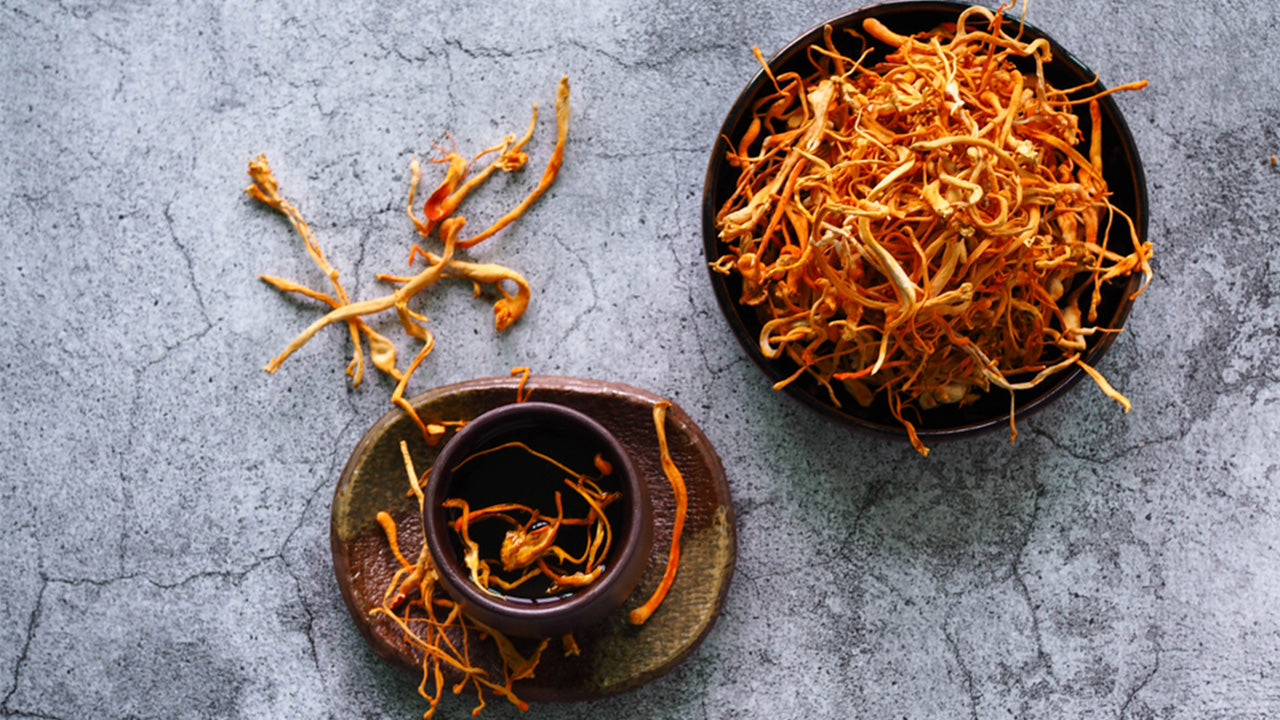Cordyceps: An Amino Acid-Rich Medicinal Mushroom
 By: by Amino Science
By: by Amino Science

More and more people now know about the incredible health benefits of medicinal mushrooms, like cordyceps. You can find mushroom teas, powders, capsules and more featuring cordyceps and extolling their extraordinary perks. A downside of all this attention is that the market has been flooded with inferior products that don’t contain the compounds that lead to the impressive health benefits driving the demand for these mushrooms.
In this article, we’ll give you an overview of some of the most important compounds found in cordyceps fungus—including several amino acids—as well as the health benefits they’re linked to so you know what to look for when evaluating different cordyceps supplement options.
Quick Facts About the Cordyceps Mushroom
The cordyceps fungus grows particularly abundantly in humid climates and tropical forests. Most of the approximately 400 species in the genus grow natively in Nepal, China, Japan, Burma, Korea, Vietnam, and Thailand.
Most species of cordyceps are endoparasitoids, meaning their mycelium invade the body of an insect host, eventually replacing the host tissue. While this may sound like something out of a horror movie—and inspired the plot of a 2013 video game—the real-life result of this process is an incredibly health-promoting mushroom.
Additional names for cordyceps include vegetable caterpillar, Chinese caterpillar fungus, dong chong xia cao, semitake, hsia ts’ao tung ch’ung, and yarsagumba. Nuclear DNA testing conducted in 2007 revealed that the Cordyceps sinensis species was unrelated to most of the other members of the genus, leading it to be renamed Ophiocordyceps sinensis.
While Cordyceps sinensis may no longer be a member of the Cordyceps family, this is the variety praised in ancient Traditional Chinese Medicine (TCM) texts like the Ben Cao Cong Xin, which was compiled in the 18th century. Cordyceps sinensis remains one of the most-valued tonic herbs in TCM and has also been the subject of numerous studies.
Cordyceps militaris is another species of this fungus family that’s received quite a lot of attention. Unlike Cordyceps sinensis, this variety grows from rice, not insects, which makes it easier to cultivate in laboratory settings.
Some believe that all laboratory-grown cordyceps are less efficacious. The price of wild-harvested cordyceps supplements can be quite cost-prohibitive, however. That means that for many consumers, reputable, high-quality cultivated cordyceps products offer an affordable way to access the impressive benefits of these medicinal mushrooms.
The Scientific Basis for Cordyceps Benefits
Analysis has shown that cordyceps contains a number of bioactive compounds, including a variety of amino acids. By isolating and extracting different compounds, researchers have begun to get a sense of which compounds result in which health benefits.
According to a 2016 study published in Food Science and Human Wellness, Cordyceps sinensis contains the following major compounds:
- Cordycepin
- Adenosine
- Ergosterol
- Nucleoside
- Nucleobases
- Codrysinins A-E
- Sterols
- Polysaccharides
Adenosine has been linked to hypotensive and vasorelaxant effects, meaning it lowers blood pressure and reduces tension in blood vessel walls. Sterols H1-A show potential as a means of managing autoimmune disorders, including lupus. And polysaccharides CME-1 exhibit highly potent antiplatelet activity, meaning they can improve circulation.
The Food Science and Human Wellness study referenced above lists the following chemical constituents for Cordyceps militaris:
- Polysaccharides
- Cerebroside derivatives
- Sterols
- Nucleotides
- Nucleosides
- Proteins including cyclic dipeptides and amino acids
- Essential oils
Tests conducted so far show that cordycepin, ergosterol, 3,4-O-isopropylidene-d-mannitol, d-mannitol, and ergosterol peroxide show the most potent anti-inflammatory effects. They even appear to influence the development of human cancer cells.
Researchers have also identified a number of amino acids, which are concentrated heavily in the fruiting bodies of the mushrooms. Some of the major amino acids identified so far are, from most to least concentrated: glutamic acid, cysteine, lysine, arginine, and tyrosine.
Key Amino Acids Found in Cordyceps

A study published in Microbiology analyzed the amino acid content of Cordyceps militaris with great precision. The results confirmed that the amino acid content for the fruiting body is higher than that of the corpus—69.32 mg/g for the former versus 14.03 mg/g for the latter. The content of individual amino acids ranged between 1.15 and 15.06 mg/g in the fruiting body and 0.36 to 2.99 mg/g for the corpus. The following amino acids were all shown to be present at concentrations of 5.00 mg/g or higher:
- Lysine: 15.06 mg/g
- Glutamic acid: 8.69 mg/g
- Proline: 6.68mg/g
- Threonine: 5.99 mg/g
- Arginine: 5.29 mg/g
- Alanine: 5.18 mg/g
- Aspartic acid: 2.66 mg/g
- Valine: 2.21 mg/g
- Tyrosine: 1.57mg/g
Cordyceps sinensis contains amino acids too. One study conducted by a team of Chinese researchers notes significant quantities of glutamic acid, tryptophan, and tyrosine, which the researchers believe play key roles in the mushroom’s sedative, calming effects.
6 Proven Cordyceps Benefits
In the centuries that it’s been in use as a valuable treatment option, cordyceps has been put to the test against numerous conditions. Here are six cordyceps uses validated by the latest scientific research.

1. Boost Immune Function
Thanks to anti-inflammatory compounds like polysaccharides, nucleosides, and cyclosporine, cordyceps offers powerful immune support. This makes it an especially valuable treatment option for conditions linked to underlying chronic inflammation, such as Crohn’s disease, arthritis, and more. A study carried out by scientists in Taiwan found that cordyceps can reduce airway inflammation, indicating it has potential as a natural asthma treatment.
2. Prevent Age-Related Cellular Damage
Cordyceps has long been reported to have significant anti-aging benefits. In 2016, groundbreaking research published in Alternatives Therapies in Health and Medicine, a peer-reviewed journal, confirmed that cordyceps has antigenotoxic properties, meaning it protects the genetic information in your cells from damage that can result in mutations. The authors concluded that Cordyceps sinensis appears to counteract the effects of oxidative stress, thereby reducing DNA damage and stimulating DNA repair.
A separate study found that due to its antioxidant effects cordyceps may even be able to prolong your lifespan! Although that particular study was conducted with fruit flies, the authors behind it say it should be explored “as a novel agent for slowing the human aging process.”
3. Improve Athletic Performance
Multiple studies indicate that cordyceps can improve your athletic performance. Cordyceps is classified as an energizing adaptogen, meaning it can holistically lift fatigue and balance out weaknesses. It also contains adenosine, a nucleic acid your body needs to produce ATP, its primary source of chemical energy.
This is likely why cordyceps has such a notable impact on physical abilities, endurance, and stamina, according to findings from researchers in the Department of Biochemistry at Hong Kong University.
4. Balance Blood Sugar Levels
A 2015 study published in the Journal of Diabetes Research found that two compounds found in cordyceps, d-mannitol cordycepin and 3’-deoxyadenosine, can lower both blood sugar levels and insulin levels. This can help to combat insulin resistance and makes cordyceps a promising potential treatment for diabetes mellitus, a leading cause of death around the globe.
5. Optimize Heart Health
Cordyceps can improve your heart health in myriad ways. According to a 2014 study, Cordyceps sinensis can improve metabolic function and prevent liver and heart damage that can accompany kidney disease.
Further research published in the Biological and Pharmaceutical Bulletin and the Journal of Pharmacological Sciences indicates cordyceps also lowers your LDL (“bad”) cholesterol levels, which can help to prevent arteriosclerosis, a condition resulting from plaque accumulation in your arteries that significantly increases your risk of both heart attack and stroke.
6. May Be Able to Treat Cancer
Several recent studies (all in-vitro) have linked cordyceps constituents to formidable anti-cancer properties. It appears to reduce the growth of lung cancer cells, liver cancer cells, and colon cancer cells.
Plus, animal studies show that cordyceps can be used as an accompaniment to conventional cancer treatments like chemotherapy and radiation to reduce unpleasant and harmful side effects including leukopenia, a condition that results in decreased numbers of white blood cells and a consequently higher risk of infection.
The Best Way to Get the Benefits of Cordyceps
As we’ve touched on, fresh cordyceps mushrooms are quite difficult to come by, due to both geographic and financial limitations. While it’s ideal to ingest fresh, whole mushrooms—and fresh, whole foods, period—Tero Isokauppila says that you can get many of the same benefits from high-quality elixers and powder.
And Isokauppila would know. He’s the founder and president of Four Sigmatic, a natural superfoods company that sells responsibly-sourced mushroom supplements, as well as the author of Healing Mushrooms: A Practical and Culinary Guide to Using Mushrooms for Whole Body Health. Isokauppila grew up on his family’s centuries-old farm in Finland, regularly foraging for mushrooms. He holds a degree in both chemistry and plant-based nutrition from Cornell University and was earned a Finnish innovation award for his discovery that a mushroom thought to grow only in Japan can be found in Finland too. Suffice it to say, he’s an expert.
When choosing a cordyceps supplement, Isokauppila says it’s important to pay attention to where the mushrooms are sourced from, how they’re processed, and how they’re packaged. “All of these factors can make a difference in the quality, and how much of the actual mushrooms you are really actually getting,” says Isokauppila.
If you’re looking at a supplement made from commercially grown mushrooms rather than foraged ones, he says to make sure the manufacturer specifies how the mushrooms were grown. “If your vendor does not cite where the mushroom was grown, it was most likely grown in sawdust or grain,” Isokaupilla says. “Since mushrooms tend to grow on logs and stumps in nature, you can be sure they’re filled with nutrients if they’re log-grown.”
He also advises checking the percentages of various active ingredients, which will give you a sense of how potent the supplement is. “You also want to look for the amount (in micrograms) of bioactive ingredients like beta-glucans, terpenoids, and triterpenes,” he says. “I recommend using 500-1,500 mg of extracted powders per serving, one to three times a day.”
Last but not least, be sure to choose cordyceps supplements that don’t include any fillers. If you keep Isokaupilla’s expert guidance in mind, you’re sure to find a cordyceps supplement that offers close to—if not completely—the same benefits as the fresh mushrooms themselves.
And if you want an even more concentrated helping of amino acids than cordyceps can provide, add essential amino acids to your supplement program. You can shop the best premium blends here.

Up to 25% off Amino
Shop NowTAGS: food supplements
Join the Community
Comments (0)
Most Craveable Recipes




 833-264-6620
833-264-6620



















